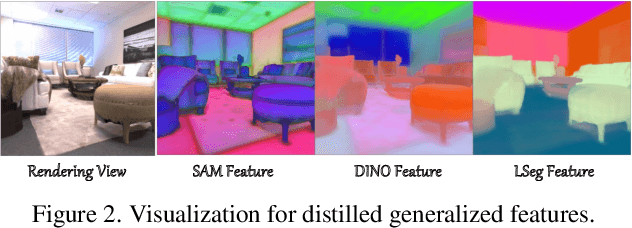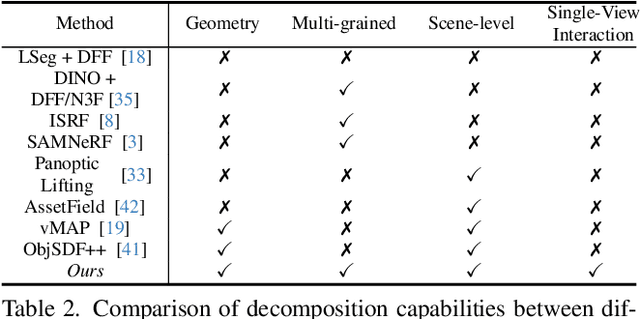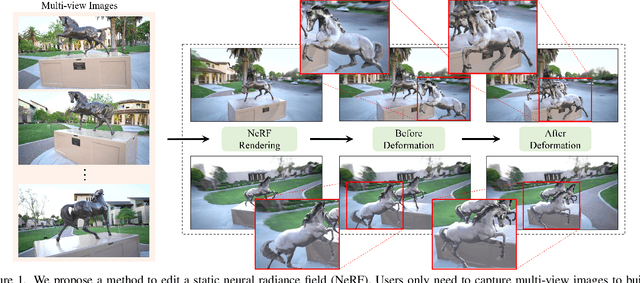Yang-Tian Sun
UniGeo: Taming Video Diffusion for Unified Consistent Geometry Estimation
May 30, 2025Abstract:Recently, methods leveraging diffusion model priors to assist monocular geometric estimation (e.g., depth and normal) have gained significant attention due to their strong generalization ability. However, most existing works focus on estimating geometric properties within the camera coordinate system of individual video frames, neglecting the inherent ability of diffusion models to determine inter-frame correspondence. In this work, we demonstrate that, through appropriate design and fine-tuning, the intrinsic consistency of video generation models can be effectively harnessed for consistent geometric estimation. Specifically, we 1) select geometric attributes in the global coordinate system that share the same correspondence with video frames as the prediction targets, 2) introduce a novel and efficient conditioning method by reusing positional encodings, and 3) enhance performance through joint training on multiple geometric attributes that share the same correspondence. Our results achieve superior performance in predicting global geometric attributes in videos and can be directly applied to reconstruction tasks. Even when trained solely on static video data, our approach exhibits the potential to generalize to dynamic video scenes.
Deformable Radial Kernel Splatting
Dec 16, 2024



Abstract:Recently, Gaussian splatting has emerged as a robust technique for representing 3D scenes, enabling real-time rasterization and high-fidelity rendering. However, Gaussians' inherent radial symmetry and smoothness constraints limit their ability to represent complex shapes, often requiring thousands of primitives to approximate detailed geometry. We introduce Deformable Radial Kernel (DRK), which extends Gaussian splatting into a more general and flexible framework. Through learnable radial bases with adjustable angles and scales, DRK efficiently models diverse shape primitives while enabling precise control over edge sharpness and boundary curvature. iven DRK's planar nature, we further develop accurate ray-primitive intersection computation for depth sorting and introduce efficient kernel culling strategies for improved rasterization efficiency. Extensive experiments demonstrate that DRK outperforms existing methods in both representation efficiency and rendering quality, achieving state-of-the-art performance while dramatically reducing primitive count.
Splatter a Video: Video Gaussian Representation for Versatile Processing
Jun 19, 2024



Abstract:Video representation is a long-standing problem that is crucial for various down-stream tasks, such as tracking,depth prediction,segmentation,view synthesis,and editing. However, current methods either struggle to model complex motions due to the absence of 3D structure or rely on implicit 3D representations that are ill-suited for manipulation tasks. To address these challenges, we introduce a novel explicit 3D representation-video Gaussian representation -- that embeds a video into 3D Gaussians. Our proposed representation models video appearance in a 3D canonical space using explicit Gaussians as proxies and associates each Gaussian with 3D motions for video motion. This approach offers a more intrinsic and explicit representation than layered atlas or volumetric pixel matrices. To obtain such a representation, we distill 2D priors, such as optical flow and depth, from foundation models to regularize learning in this ill-posed setting. Extensive applications demonstrate the versatility of our new video representation. It has been proven effective in numerous video processing tasks, including tracking, consistent video depth and feature refinement, motion and appearance editing, and stereoscopic video generation. Project page: https://sunyangtian.github.io/spatter_a_video_web/
Total-Decom: Decomposed 3D Scene Reconstruction with Minimal Interaction
Mar 30, 2024



Abstract:Scene reconstruction from multi-view images is a fundamental problem in computer vision and graphics. Recent neural implicit surface reconstruction methods have achieved high-quality results; however, editing and manipulating the 3D geometry of reconstructed scenes remains challenging due to the absence of naturally decomposed object entities and complex object/background compositions. In this paper, we present Total-Decom, a novel method for decomposed 3D reconstruction with minimal human interaction. Our approach seamlessly integrates the Segment Anything Model (SAM) with hybrid implicit-explicit neural surface representations and a mesh-based region-growing technique for accurate 3D object decomposition. Total-Decom requires minimal human annotations while providing users with real-time control over the granularity and quality of decomposition. We extensively evaluate our method on benchmark datasets and demonstrate its potential for downstream applications, such as animation and scene editing. The code is available at https://github.com/CVMI-Lab/Total-Decom.git.
3DGSR: Implicit Surface Reconstruction with 3D Gaussian Splatting
Mar 30, 2024Abstract:In this paper, we present an implicit surface reconstruction method with 3D Gaussian Splatting (3DGS), namely 3DGSR, that allows for accurate 3D reconstruction with intricate details while inheriting the high efficiency and rendering quality of 3DGS. The key insight is incorporating an implicit signed distance field (SDF) within 3D Gaussians to enable them to be aligned and jointly optimized. First, we introduce a differentiable SDF-to-opacity transformation function that converts SDF values into corresponding Gaussians' opacities. This function connects the SDF and 3D Gaussians, allowing for unified optimization and enforcing surface constraints on the 3D Gaussians. During learning, optimizing the 3D Gaussians provides supervisory signals for SDF learning, enabling the reconstruction of intricate details. However, this only provides sparse supervisory signals to the SDF at locations occupied by Gaussians, which is insufficient for learning a continuous SDF. Then, to address this limitation, we incorporate volumetric rendering and align the rendered geometric attributes (depth, normal) with those derived from 3D Gaussians. This consistency regularization introduces supervisory signals to locations not covered by discrete 3D Gaussians, effectively eliminating redundant surfaces outside the Gaussian sampling range. Our extensive experimental results demonstrate that our 3DGSR method enables high-quality 3D surface reconstruction while preserving the efficiency and rendering quality of 3DGS. Besides, our method competes favorably with leading surface reconstruction techniques while offering a more efficient learning process and much better rendering qualities. The code will be available at https://github.com/CVMI-Lab/3DGSR.
NeRF-Editing: Geometry Editing of Neural Radiance Fields
May 10, 2022



Abstract:Implicit neural rendering, especially Neural Radiance Field (NeRF), has shown great potential in novel view synthesis of a scene. However, current NeRF-based methods cannot enable users to perform user-controlled shape deformation in the scene. While existing works have proposed some approaches to modify the radiance field according to the user's constraints, the modification is limited to color editing or object translation and rotation. In this paper, we propose a method that allows users to perform controllable shape deformation on the implicit representation of the scene, and synthesizes the novel view images of the edited scene without re-training the network. Specifically, we establish a correspondence between the extracted explicit mesh representation and the implicit neural representation of the target scene. Users can first utilize well-developed mesh-based deformation methods to deform the mesh representation of the scene. Our method then utilizes user edits from the mesh representation to bend the camera rays by introducing a tetrahedra mesh as a proxy, obtaining the rendering results of the edited scene. Extensive experiments demonstrate that our framework can achieve ideal editing results not only on synthetic data, but also on real scenes captured by users.
 Add to Chrome
Add to Chrome Add to Firefox
Add to Firefox Add to Edge
Add to Edge